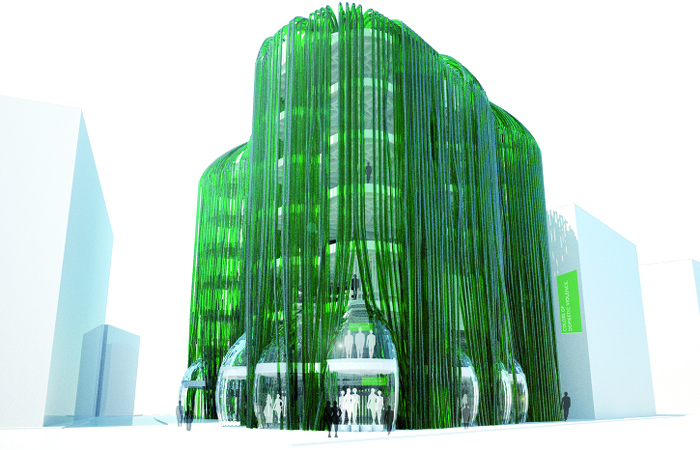Algae
There is lots of talk about green buildings, but what if they were actually green?
ecoLogicStudio, a London architectural and design firm created a 430 ft sq. gazebo called the Urban Algae Folly at Expo 2015. The Folly produces oxygen and absorbs considerable amounts of carbon dioxide with algae-filled plastic serving as a living 'skin'.
The Folly is made of ethylene tetrafluoroethylene (ETFE), a transparent plastic material. Its hollow interior is filled with water and spirulina, a type of algae often used as a dietary supplement. The growth of the algae depends on sunlight and temperature.
Algae and other marine plants make 70% of the world’s oxygen. The Folly produces about 4.4 pounds of oxygen per day and can also suck about 8.8 pounds of carbon dioxide from the air per day. This is compared with a tree which absorbs only about .132 pounds.
Algae has also been used in a number of other recent urban innovations. French biochemist Pierre Calleja created a prototype for a 'smog-eating' street lamp, which uses bioluminescent microalgae to light streets while absorbing carbon dioxide and producing oxygen.
NB Legionnaires' Disease - Operation and Maintenance Log Book (BG 58/2015), written by Reginald Brown and Salim Deramchi, and published by BSRIA in May 2015, defines algae as: ‘Small, usually aquatic, plants that require light to grow, often found on exposed areas of cooling towers’.
This article was originally published as 'A cloak of algae' by BRE Buzz on 13 Sept 2016 written by Sheila Swan.
[edit] Related articles on Designing Buildings
Featured articles and news
The UK's Modern Industrial Strategy: A 10 year plan
Previous consultation criticism, current key elements and general support with some persisting reservations.
Building Safety Regulator reforms
New roles, new staff and a new fast track service pave the way for a single construction regulator.
Architectural Technologist CPDs and Communications
CIAT CPD… and how you can do it!
Cooling centres and cool spaces
Managing extreme heat in cities by directing the public to places for heat stress relief and water sources.
Winter gardens: A brief history and warm variations
Extending the season with glass in different forms and terms.
Restoring Great Yarmouth's Winter Gardens
Transforming one of the least sustainable constructions imaginable.
Construction Skills Mission Board launch sector drive
Newly formed government and industry collaboration set strategy for recruiting an additional 100,000 construction workers a year.
New Architects Code comes into effect in September 2025
ARB Architects Code of Conduct and Practice available with ongoing consultation regarding guidance.
Welsh Skills Body (Medr) launches ambitious plan
The new skills body brings together funding and regulation of tertiary education and research for the devolved nation.
Paul Gandy FCIOB announced as next CIOB President
Former Tilbury Douglas CEO takes helm.
UK Infrastructure: A 10 Year Strategy. In brief with reactions
With the National Infrastructure and Service Transformation Authority (NISTA).
Ebenezer Howard: inventor of the garden city. Book review.
The Grenfell Tower fire, eight years on
A time to pause and reflect as Dubai tower block fire reported just before anniversary.
Airtightness Topic Guide BSRIA TG 27/2025
Explaining the basics of airtightness, what it is, why it's important, when it's required and how it's carried out.
Construction contract awards hit lowest point of 2025
Plummeting for second consecutive month, intensifying concerns for housing and infrastructure goals.
Understanding Mental Health in the Built Environment 2025
Examining the state of mental health in construction, shedding light on levels of stress, anxiety and depression.






















